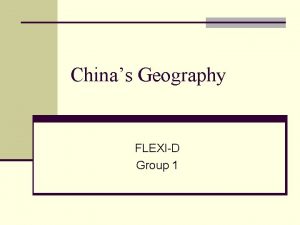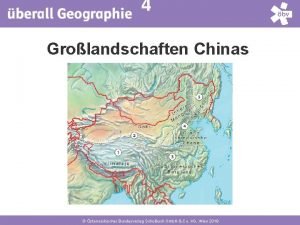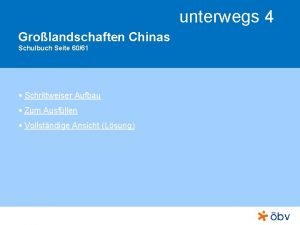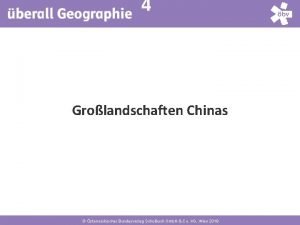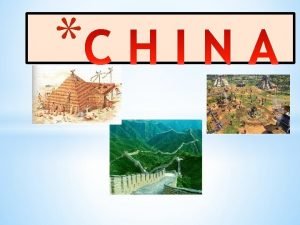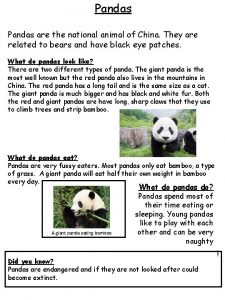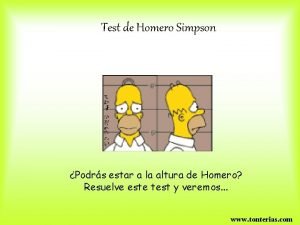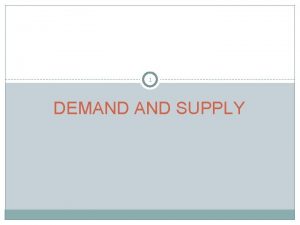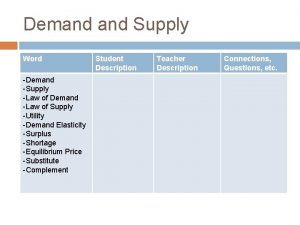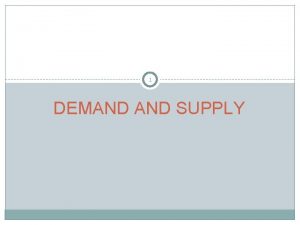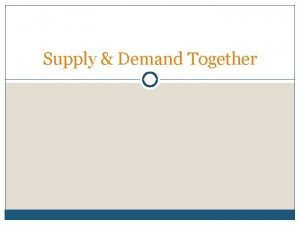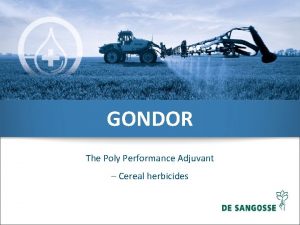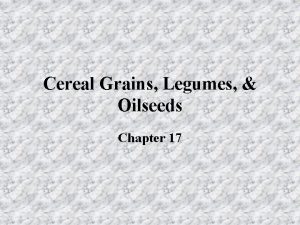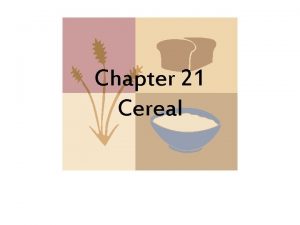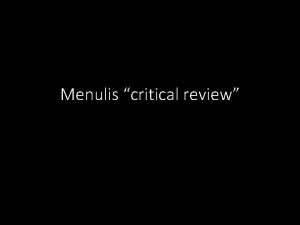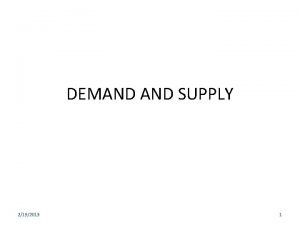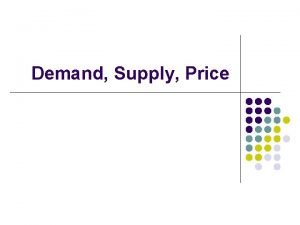CRITICAL REVIEW OF CHINAS CEREAL SUPPLY DEMAND IMPLICATIONS




















- Slides: 20

CRITICAL REVIEW OF CHINA’S CEREAL SUPPLY & DEMAND IMPLICATIONS FOR WORLD MARKETS S. 1 CRITICAL REVIEW OF CHINA’S CEREAL SUPPLY & DEMAND IMPLICATIONS FOR WORLD MARKETS Joint Meeting of the 30 th Session of the Intergovernmental Group on Grains and the 41 st Session of the Intergovernmental Group on Rice Rome 10 -11 February 2004 CCP: GR-RI 04/CRS. 3

CRITICAL REVIEW OF CHINA’S CEREAL SUPPLY & DEMAND IMPLICATIONS FOR WORLD MARKETS S. 2 Overview of the presentation § § § § Background Main issues “Cereals” and Sources Food use estimates Feed use estimates Stocks Implications

CRITICAL REVIEW OF CHINA’S CEREAL SUPPLY & DEMAND IMPLICATIONS FOR WORLD MARKETS S. 3 Background § China in global economy § Reasons for FAO’s first revision of China’s cereal balances (2000) § Impacts on world numbers § Steady decline in China’s stocks since 1999 § Need for more detailed review and analysis § FAO cereal balances: GIEWS and FAOSTAT § Research inputs and main collaborators

CRITICAL REVIEW OF CHINA’S CEREAL SUPPLY & DEMAND IMPLICATIONS FOR WORLD MARKETS S. 4 Issues § What do we know about cereal supply and demand in China? § Are domestic cereal supplies adequate to meet demand? § How to determine the “accurate” level of stocks in China and are they falling so massively? § China, a major source of instability in world cereal markets?

CRITICAL REVIEW OF CHINA’S CEREAL SUPPLY & DEMAND IMPLICATIONS FOR WORLD MARKETS Few words about “cereals” in China. . . § Main cereals grown and consumed in China include: wheat, rice, maize, barley, rye, oats, millet and sorghum; § But cereals are referred to as “grains” in China, which also include soybeans and roots crops (mainly sweet potatoes); § Wheat, rice and maize production amounts to roughly 97% of the total cereal output in China; § Wheat (north) and rice (south) are used mostly for food while maize is used primarily as feed. S. 5

CRITICAL REVIEW OF CHINA’S CEREAL SUPPLY & DEMAND IMPLICATIONS FOR WORLD MARKETS S. 6 Basic official sources: § Ministry of Agriculture: collects production and price data based on data supplied by the provinces and counties; § The Chinese National Bureau of Statistics (NBS) formerly the Statistical Bureau (SSB) - collects production data based on yield sampling survey; consumption data based on household survey; year -end stocks in per capita term for rural households [“China Rural Household Survey Yearbook”, “China Statistical Yearbook”, “Yearbook of China Prices and Survey of Urban Household Expenses”]; § Custom: collects monthly trade data; § Ministry of Domestic Trade: collects data on state purchasing and state reserve and quota price data

CRITICAL REVIEW OF CHINA’S CEREAL SUPPLY & DEMAND IMPLICATIONS FOR WORLD MARKETS A simple cereal supply & demand balance: what is “official” and what is not! § § Total Supply official • Production • Opening stocks Unofficial estimates • Imports official Total Utilization • Domestic Utilization • Food use Unofficial estimates • Feed use • Other use • Exports official Unofficial estimates • Ending Stocks S. 7

CRITICAL REVIEW OF CHINA’S CEREAL SUPPLY & DEMAND IMPLICATIONS FOR WORLD MARKETS FAO/GIEWS per capita wheat consumption estimates are above the adjusted NBS figures but both series show a sharp decline FAO/GIEWS NBS * (. . . million tonnes. . . ) FAO/GIEWS NBS * (. . . per capita in Kg/year. . . ) 1995/96 99 92 82 77 1996/97 100 94 82 77 1997/98 101 92 83 75 1998/99 102 91 82 74 1999/00 102 91 82 73 2000/01 100 91 80 73 2001/02 99 88 78 70 2002/03 98 87 77 69 S. 8

CRITICAL REVIEW OF CHINA’S CEREAL SUPPLY & DEMAND IMPLICATIONS FOR WORLD MARKETS FAO/GIEWS per capita rice consumption estimates are above the adjusted NBS figures and NBS numbers show faster declines FAO/GIEWS NBS * (. . . million tonnes. . . . ) FAO/GIEWS NBS * (. . . per capita in kg. . ) 1995/96 107 104 90 87 1996/97 109 103 90 85 1997/98 110 101 90 83 1998/99 111 100 90 82 1999/00 112 97 90 78 2000/01 112 100 89 80 2001/02 112 98 89 77 2002/03 112 97 88 77 S. 9

CRITICAL REVIEW OF CHINA’S CEREAL SUPPLY & DEMAND IMPLICATIONS FOR WORLD MARKETS S. 10 Calculating feed use § Two approaches to estimate feed grain utilization: • supply” or “availability” approach (i. e. the feed use = total grain production-food useseed use-waste and other uses). • “utilization” approach (i. e. the feed use = meat production multiplied by corresponding overall feed conversion factor, which are intended to reflect both the intensity and the technical efficiency of the livestock system).

CRITICAL REVIEW OF CHINA’S CEREAL SUPPLY & DEMAND IMPLICATIONS FOR WORLD MARKETS Three different feed requirement scenarios could be considered for the period 1996 to 2001 Low scenario Middle scenario High scenario 1996 167 207 224 1997 186 216 233 1998 173 207 226 1999 185 212 229 2000 176 194 210 2001 183 202 218 (million tonnes) S. 11

CRITICAL REVIEW OF CHINA’S CEREAL SUPPLY & DEMAND IMPLICATIONS FOR WORLD MARKETS S. 12 How much grains are available for livestock production? § Based on FAO/GIEWS estimates, total amount of grains used as feed would be in the range of 150 -180 mt, which would be closer to the grain feed requirements under the low scenario. § Chinese farmers contribute about 70 -100 mt and the milling enterprises another 40 -50 mt. In addition, feed use by larger scale livestock producers (and milling companies) need also to be taken into consideration since they purchase feed ingredients and produce their own compound feed.

CRITICAL REVIEW OF CHINA’S CEREAL SUPPLY & DEMAND IMPLICATIONS FOR WORLD MARKETS S. 13 Stocks in China § Government stocks: • State (central government); • Special Grain Reserves (SAGR) established in 1990 s • local government stocks; and “business” stocks held by the State Owned Enterprises (SOE). § On-farm Stocks

CRITICAL REVIEW OF CHINA’S CEREAL SUPPLY & DEMAND IMPLICATIONS FOR WORLD MARKETS S. 14 The adjusted cereal stock estimates would be higher than FAO’s but. . . Derived Gov. Stocks Adjusted On-farm Stocks Adjusted Total Cereal Stocks FAO/GIEWS Total Stocks (. . million tonnes. . ) 1994/95 120 141 261 350 1995/96 166 140 306 358 1996/97 208 111 319 372 1997/98 233 151 384 368 1998/99 259 210 469 375 1999/00 235 155 390 368 2000/01 250 96 346 318 2001/02 204 105 309 265

CRITICAL REVIEW OF CHINA’S CEREAL SUPPLY & DEMAND IMPLICATIONS FOR WORLD MARKETS S. 15 China’s cereal production has been falling while utilization seems flat, is the gap real, what about the future?

CRITICAL REVIEW OF CHINA’S CEREAL SUPPLY & DEMAND IMPLICATIONS FOR WORLD MARKETS S. 16 Can stocks fall to nil?

Wheat imports have started to rise while maize exports are declining as stocks fall sharply. . . Imports and Exports Stocks 4 /0 03 0 /0 99 5 /9 94 0 /9 89 5 /8 84 0 /8 79 4 /0 03 0 /0 99 5 /9 94 0 /9 89 /8 5 million tonnes 84 /8 0 million tonnes 79 CRITICAL REVIEW OF CHINA’S CEREAL SUPPLY & DEMAND IMPLICATIONS FOR WORLD MARKETS S. 17

CRITICAL REVIEW OF CHINA’S CEREAL SUPPLY & DEMAND IMPLICATIONS FOR WORLD MARKETS S. 18 Domestic cereal prices have started to increase, but RMB/tonne Rice (Japonica) Rice (Early Indica) Wheat Maize Selected Wholesale Cereal Prices in China, 2000 -2003

CRITICAL REVIEW OF CHINA’S CEREAL SUPPLY & DEMAND IMPLICATIONS FOR WORLD MARKETS S. 19 What Next? § It is certain that cereal stocks in China must have fallen substantially in recent years § And that much of the drawdown in world stocks has been due to a sharp decline in China’s cereal stocks § But, we still need to substantiate what may or may not be the real level of stocks in China § As long as FAO does not have reliable and consistent information about the overall level of stocks in China, the Organisation’s assessment of the global cereal market situation will not be reliable

CRITICAL REVIEW OF CHINA’S CEREAL SUPPLY & DEMAND IMPLICATIONS FOR WORLD MARKETS S. 20 WELCOME TO THE YEAR OF MONKEY AND THANK YOU A monkey practices acrobatic skills on the horns of a goat in the Changchun Fauna and Flora Garden in the capital of Jilin Province in Northeast China. [China Daily]
 Critical semi critical and non critical instruments
Critical semi critical and non critical instruments Semi-critical
Semi-critical Module 5 supply and demand introduction and demand
Module 5 supply and demand introduction and demand Matching supply and demand in supply chain
Matching supply and demand in supply chain Damas chinas instrucciones
Damas chinas instrucciones Whats chinas longest river
Whats chinas longest river Großlandschaften chinas
Großlandschaften chinas China großlandschaften karte
China großlandschaften karte Chinas physical features
Chinas physical features Dynastys of china
Dynastys of china China großlandschaften
China großlandschaften Regiones chinas
Regiones chinas The national animal of china
The national animal of china National animal of germany
National animal of germany Tomografia homero simpson
Tomografia homero simpson Ancient chinas geography
Ancient chinas geography Slidetodoc.com
Slidetodoc.com Inventory modeling
Inventory modeling Measures to correct excess and deficient demand
Measures to correct excess and deficient demand Individual demand vs market demand
Individual demand vs market demand Dependant demand
Dependant demand





